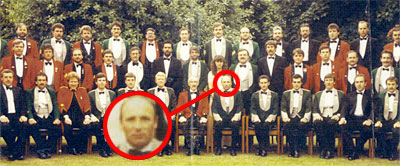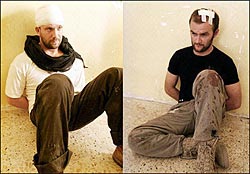Exposing Gordon Kerr and Tony Blair’s secret army
April 2007 http://www.socialistworker.org.uk/art.php?id=11105

The secret Force Research Unit, the British Army’s counter-intelligence squad, pictured in 1988. The circled man is Gordon Kerr - now in Iraq

British soldiers from the SRR unit arrested in Iraq in 2005
Two of Britain’s most secret military units operating in Iraq are run by a man who ran death squads in Northern Ireland.
British covert military unit the Joint Support Group (JSG) works alongside US covert forces in the aptly named “Task Force Black”.
Earlier this year the JSG was lauded in the Sunday Telegraph for its role in running dozens of double agents in Iraq, many of who had infiltrated the various insurgent groups and militias.
The Telegraph claimed the regiment is “one of the coalition’s most effective and deadly weapons in the fight against terror”.
The other unit is the Special Reconnaissance Regiment (SRR). At its creation in 2005, suitably anonymous “military sources” told the media, “We want to place electronic ‘bugs’ close to terrorist leaders such as Osama bin Laden and have agents within the ranks of global terrorist groups.
Shooting
“We got very good at doing this in Northern Ireland in the 1980s and 1990s, and now we want to transfer this capability to the global war on terrorism.”
In July 2005, the SRR was involved in the surveillance operation which led to the shooting of Jean Charles de Menezes at Stockwell tube station in London.
SRR officers were apparently engaged in “low-level intelligence behind the scenes” when Jean Charles was shot. According to the “military sources”, this was the first time the new regiment had been engaged in an operation.
In December that year two British soldiers in the SRR were arrested by police in Iraq.
Who were the two men and what were they doing when they were seized outside al-Jamiat police station in Basra?
What prompted British soldiers to smash down the wall of the station and demolish several buildings inside the compound in the operation to snatch them back?
At the request of the MoD, the British media obscured the faces of the two captured men (pictured above).
They had been sitting in a car outside the police station in Arabic dress. They were heavily armed and had an impressive array of surveillance equipment with them.
It was claimed at the time that the two undercover men had opened fire when they were stopped at a police roadblock, killing at least one police officer. They were part of the Britain’s undercover war in Iraq.
Both the JSG and the SRR are run by Brigadier Gordon Kerr.
Kerr’s career has taken him to troublespots all over the world. An officer in the Gordon Highlanders, he served briefly in Cyprus before his first posting in Northern Ireland in 1972.
Tony Blair appointed Kerr to head up military intelligence in Iraq in 2003 – just two weeks after an inquiry into collusion with paramilitaries in Northern Ireland sent a file about Kerr to the director of public prosecutions.
Kerr is the most senior serving intelligence officer in the army and has been rewarded with both an OBE and the queen’s gallantry medal.
In Iraq Kerr applies the “methods developed on the mean streets of Ulster during the Troubles”, as the Sunday Telegraph excitedly relates.
The government has repeatedly claimed that Northern Ireland provides the blueprint for the British army’s operations in Iraq.
Paramilitaries
From the late 1970s, various British governments backed a secret unit of the army, the Force Research Unit (FRU), which, along with the special branch of the Royal Ulster Constabulary, supplied names, addresses and photographs of Catholic targets to Loyalist paramilitaries.
The FRU was led by Gordon Kerr. When Kerr became the FRU’s commander in 1986, the 100-strong squad adopted a more aggressive approach to the running of informers.
The key person supplying information was British army agent Brian Nelson.
He infiltrated the Ulster Defence Association (UDA), the biggest Loyalist paramilitary group. His information was responsible for the murder of at least 30 Catholics.
These included many who had no connection to the IRA, including the Belfast solicitor Pat Finucane who was murdered in 1989 by the UDA’s death squad, the Ulster Freedom Fighters.
The FRU also obtained “restriction orders” from other British security and military units whereby the FRU would withdraw from an area to allow Kerr’s UDA agents to get in and out without hindrance.
Drawing on his sources in British intelligence, Nelson passed on the names and addresses of apparent IRA activists to the UDA, whose gunmen would promptly go out and “execute” the suspects.
Nelson’s activities were regularly discussed at London meetings of the Joint Intelligence Committee.
This was chaired by then Tory prime minister Margaret Thatcher.
In January 1992 Nelson agreed to plead guilty to five conspiracies to murder, and at least four sectarian murder charges against him were dropped.
In a bizarre court case lasting less than a day, Nelson’s real role was effectively covered up. After a moving tribute to his sterling work for the British army from an anonymous colonel, Nelson got ten years.
Speaking from behind a security screen the colonel stressed the lives Nelson had allegedly “saved”. Nelson was released after serving less than half his sentence, and spent the rest of his life under a false identity.
The anonymous colonel was Gordon Kerr.
Beyond Gordon Kerr, the Special Reconnaissance Regiment includes at least 100 other veterans of Britain’s dirty war in Northern Ireland.
How much does Tony Blair know about what they are up to?
© Socialist Worker (unless otherwise stated). You may republish if you include an active link to the original.